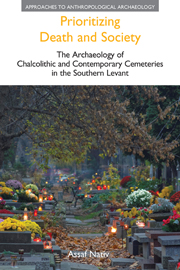 Prioritizing Death and Society
Prioritizing Death and Society from Part I - Introduction
This book proposes a comparative analysis of distinct cultural systems. If it differs from other comparative studies, it is in its lack of contextual justification for the choice of objects for comparison; they are neither contemporaneous nor do they represent a continuous development. Moreover, the comparative effort is to a considerable extent oriented towards the elucidation of qualitative difference. In this it is set apart from a range of more common aims, generally oriented to the establishment of links: statistical evaluation of theories, measurement of variability, identification of material correlates for social features (e.g. gender roles, social ranking) and substantiating correlations between variables and evolutionary processes (see Peregeine 2004).
These features, I feel, set this study sufficiently apart from most others to warrant justification and an explicit account of its theoretical reasoning. Four elementary concepts will be discussed in this regard: binary opposition, logical gap, cultural arbitrariness and thick description. Together these concepts will demonstrate the efficacy, relevance and justification of the present research design; they will also clarify some important tenets of the approach in question. Finally, several examples will be offered to further substantiate the claims.
Binary oppositions
The concept of the binary opposition was developed in the field of structural linguistics and stems from the Saussurian tenet that the meaning of a word or a sign is a function of its opposition to others — that is, every term is conceived through what the others are not.
To save this book to your Kindle, first ensure [email protected] is added to your Approved Personal Document E-mail List under your Personal Document Settings on the Manage Your Content and Devices page of your Amazon account. Then enter the ‘name’ part of your Kindle email address below. Find out more about saving to your Kindle.
Note you can select to save to either the @free.kindle.com or @kindle.com variations. ‘@free.kindle.com’ emails are free but can only be saved to your device when it is connected to wi-fi. ‘@kindle.com’ emails can be delivered even when you are not connected to wi-fi, but note that service fees apply.
Find out more about the Kindle Personal Document Service.
To save content items to your account, please confirm that you agree to abide by our usage policies. If this is the first time you use this feature, you will be asked to authorise Cambridge Core to connect with your account. Find out more about saving content to Dropbox.
To save content items to your account, please confirm that you agree to abide by our usage policies. If this is the first time you use this feature, you will be asked to authorise Cambridge Core to connect with your account. Find out more about saving content to Google Drive.